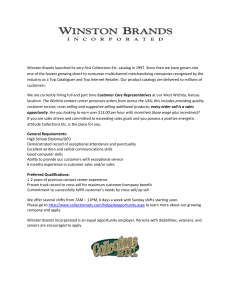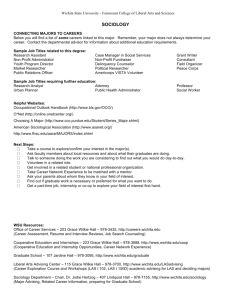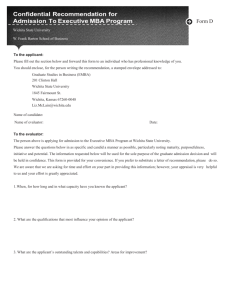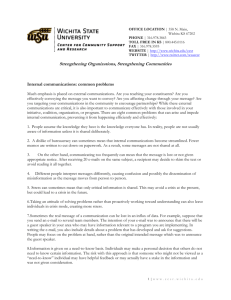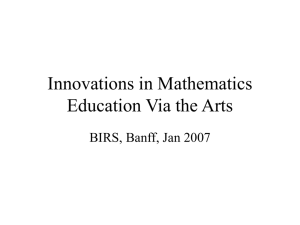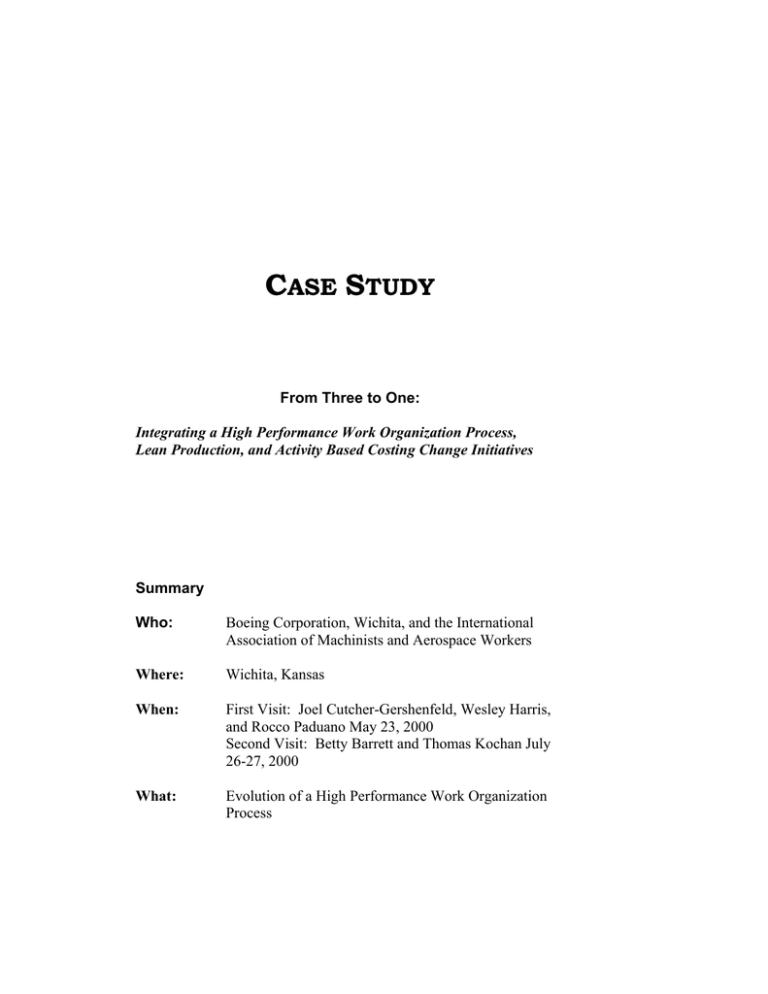
CASE STUDY
From Three to One:
Integrating a High Performance Work Organization Process,
Lean Production, and Activity Based Costing Change Initiatives
Summary
Who:
Boeing Corporation, Wichita, and the International
Association of Machinists and Aerospace Workers
Where:
Wichita, Kansas
When:
First Visit: Joel Cutcher-Gershenfeld, Wesley Harris,
and Rocco Paduano May 23, 2000
Second Visit: Betty Barrett and Thomas Kochan July
26-27, 2000
What:
Evolution of a High Performance Work Organization
Process
Executive Summary
Key challenges and lessons learned
In 1997 Boeing’s Wichita Division and the International Association
of Machinists and Aerospace Workers agreed to launch a “High
Performance Work Organization” (HPWO) process. This followed the
introduction of a Lean Production Initiative in 1994-95 and an Activity
Based Costing (ABC) initiative in 1996. Managers and union leaders
in Wichita sought to sustain and grow each of
these change and improvement efforts in Managers and
ways that empower the workforce and union leaders in
enhance the competitiveness of the Wichita sought to
operations. Although these initiatives share …empower the
some similar objectives and could potentially workforce…
serve to complement and reinforce each
other, to date they have been led and managed separately. Each is
experiencing a slow and difficult path of diffusion. The key challenge
facing management and union leaders is to decide how to best
integrate these separate improvement programs into a single, focused
initiative that builds broader awareness, support, and demand for its
features across all levels of the workforce and the management and
union organizations in the Wichita operation. Given the combination
of the engineering culture of Boeing and the pragmatic orientation of
the workforce in Wichita, the parties may want to shift to a more
targeted task or problem specific approach that engages a broad cross
section of hourly workers, engineers, and managers in specific
improvement initiatives. Doing so might shift from a top-down
supplier push to a distributed, demand-pull process of innovation and
adaptation.
The most significant external threats to the success of these efforts and
the stability of the enterprise are the perceived threat of losing
products and projects to other Boeing facilities or to external suppliers,
and the corresponding insecurities and fear of downsizing on the part
of the workforce. However, these external threats are not as
significant as internal factors, particularly, the lack of consistent
leadership support and follow-through within both the company and
union organizations. Other sources of instability are the conflicts and
political pressures that occur in the on-going labor management
relationships and spillover to slow down or disrupt temporarily the
ability of the parties to work together on these joint improvement
efforts.
1
Mitigation Strategies
The good news is that steps to mitigate these potential threats can be
identified since they are quite similar to those often encountered and
overcome by other organizational change efforts. This is particularly
true because the HPWO, as well as the lean production and ABC
efforts are all still in their pilot or early stages of development. The
mitigation strategies suggested by other cases would call for:
1. Integration of HPWO, lean production, and ABC change
efforts;
2. Shift to a demand-pull project/problem specific
improvement strategy;
3. Creation of a stable pool of funds to support proposals for
improvement projects;
4. Commitment by both management and union leaders to
protect their joint improvement processes from being “held
hostage” to the normal political cycle of union elections,
collective bargaining negotiations, leadership and staff
turnover, or other conflicts that occur.
Boeing in Wichita
Boeing’s Wichita Division supports the commercial, military, and
space products and services of the Boeing Corporation. Operations in
Wichita date back to the old Stearman Aircraft Company, which
became part of Boeing in 1934 when the federal government required
United Airlines, Pratt and Whitney, and Boeing to split into three
separate companies.
Presently, the Wichita Division employs
approximately 16,800 employees, down from approximately 20,000 in
1997. It is the largest employer in the State of Kansas. The division
produces 75 percent of the parts for Boeing’s 737 commercial airliner
as well nacelles, nose sections and other parts for Boeing’s 747, 757,
767, and 777 as well as a range of maintenance services and parts for
the company’s military and commercial products.
Sources of Instability: Wichita and other Aerospace Facilities
Table 1 summarizes the differences between sources of instability at
Wichita and the average of four other plants in the aerospace industry.
The data come from survey data collected from a cross section of
managers, engineers, and hourly personnel in Wichita.
Their
responses are compared to the average responses from comparable
samples of employees in four sister aerospace industry facilities. We
break the sources of instability down into two categories. The top
panel reports external sources of instability, i.e., those that come from
2
customers, markets, technologies, or suppliers while the bottom panel
lists internal sources of instability that come from actions or decisions
controllable within the company or plant. The data show that Wichita
plants surveyed and more internally
Wichita employees report
generated instability.
Wichita
greater instability coming from
employees report significantly less
internal company and/or plant
instability from externally generated
decisions…than their
budget shifts or changes in technology
counterparts in other plants.
and no differences in the other external
categories.
In contrast, Wichita
employees report greater instability
coming from internal company and/or
plant decisions in five of six categories than their counterparts in other
plants. The highest-ranking source of instability is perceived changes
in leadership vision, followed by changes in internal budgets and
stresses and tensions associated with changes in the plant.
Table 1
Sources of Instability: Wichita and Other Aerospace Plants
EXTERNAL SOURCES OF
INSTABILITY
Budget allocations
Product demand
Customer requirements
Equipment/technology
Supplier performance
AVERAGE OF
OTHER PLANTS
0.98
1.23
1.28
2.09
0.96
WICHITA
DIFFERENCE
0.27
1.28
1.26
1.21
0.96
-0.71
+0.05
+0.02
-0.61
0.00
INTERNAL SOURCES OF
INSTABILITY
Internal budgets
Voluntary turnover
Reengineering
Leadership vision
Tension/stress around change
Subcontract out work
In sourcing of work
0.98
0.95
0.96
1.01
1.11
.059
0.49
1.25
0.91
1.12
1.29
1.19
0.92
0.58
+0.27
- 0.04
+0.16
+0.28
+0.08
+0.33
+0.09
The HPWO Initiative
Unlike most similar efforts introduced into American companies over
the past twenty years, the process and elements of the HPWO program
were built around a model developed by the IAM’s High Performance
Work Organization Partnerships Department rather than around a
3
strategy initiated by the company. The decision to embark on this
program arose out of conversations between Richard Schneider, the
IAM Vice President responsible for aerospace industry and Jerry
Calhoun, Boeing Corporation’s Vice President of Labor Relations.
They wanted to start an initiative somewhere in the company and felt
that Wichita would be a good option because of the good relationships
among top management and labor leaders there.
This decision reflected a shift in IAM philosophy and strategy toward
employee participation. For many years, the IAM was skeptical and
suspicious of the motives behind company initiated participatory
efforts, seeing them as efforts to undermine local unions where they
were present and avoid unions where a facility was not
organized. Given this view, international leaders In the late 1990’s,
urged locals to not participate in such efforts. In the the IAM strategy
late 1990s, the IAM strategy shifted. Top union shifted.
leaders decided to take a proactive approach by
outlining a model HPWO program with full union
participation and co-management. The union set up a department to
promote and support this effort. Figure 1 summarizes the elements in
the IAM HPWO model.
Two years after the agreement to launch the initiative, the program
showed significant potential.
A first pilot project had been
implemented in the strut drill out machine shop—a unit that produces
titanium engine mounts for the 737 and 777. But warning signals were
clearly present. Union and management leaders all agreed the process
was moving slowly.
Moreover, the program seemed to be
experiencing many of the same dilemmas and challenges that prior
HPWO programs in other companies have experienced. The question
posed in this case is whether the parties can learn from the experiences
of others and use these challenges or pivotal events to reinforce and
strengthen the effort. Or will they repeat the same mistakes or
behavioral patterns that have stalled or destroyed similar programs in
other companies?
Evolution of the Process. As noted above, the HPWO program
was a top-down initiative stimulated by corporate and international
union leaders’ desire to pilot a new approach to labor management
relations. This is consistent with the perception the workforce at
Wichita has of most change programs. In response to a question in the
survey, 59 percent see change at Wichita initiated by corporate
executives and 27 percent see change as coming from Wichita
executives. In contrast, only 8 percent see change as arising
negotiated changes involving all parties with a stake in the issue and
even fewer (6 percent) see change as coming from the “bottom-up by
4
employees.” The effect of this is to place a high reliance on corporate
and plant level leaders to continue to lead the process.
Top management and union leaders were active and instrumental in
launching the HPWO efforts. They attended a weeklong training
session with union counterparts at the IAM’s traning facility in Placid
Harbor, Maryland. All accounts of that week of learning and
interaction were very positive. Out of it came a shared commitment
and plan for implementing the HPWO program consistent with the
IAM guidelines shown in Figure 1. Our interviews with the key
leaders indicated that they continue to be committed to goals of the
HPWO initiative. However, there does not appear to be a shared view
for how to move the process forward.
Jeff Turner, the Vice President and General Manager of Wichita
operations, sees the HPWO initiative as a vehicle for improving
flexibility, costs and labor management relations. He recognizes the
need for union leaders to share ownership of the process and attributes
the failures of prior efforts to introduce quality improvement programs
to the lack of union involvement in them. But he also expresses some
frustration with the slow pace of change and the inability of the
company and the union to develop a shared vision regarding the
challenges facing industry in general and Boeing and the Wichita
operations in particular. In his words:
HPWO appears to be the only way I can get the IAM to move
with us. The world is moving away from us---our labor
relations are part of an anachronistic system. The last
contract—we just didn’t get it, we were like ships passing in
the night. We [management] see the whole issue as being lean
and efficient and expanding our markets where you really have
confidence in your ability and partner with others who are good
at other things.
For our part, we have been naïve on how incredibly important
it is to recognize the legitimacy of the union and to see their
shared interest in growing the business—if the union is left out
of this they feel their legitimacy is being undermined.
Time is the
major
constraint …in
supporting the
HPWO effort.
Jeff, therefore, sees it as his responsibility to
diversify and grow the business without building in
employment swings, and to involve the union in this
process. That is why he supports the HPWO
process. Time is the major constraint he faces in
supporting the HPWO effort. He is responsible for
moving multiple initiatives forward at Wichita,
5
including the lean production and activity based costing efforts.
This vision is quite similar to that of Ron Eldridge, the IAM Directing
Business Agent and statewide leader. Ron hopes that the HPWO
effort will help transform labor management relations from its old, and
in his view, outdated arms’ length model to one that truly empowers
employees and involves the union as a partner with management in
maintaining the work currently done at Wichita and/or bringing in new
work:
The HPWO process started slow because of mistrust from our
history. But by going through HPWO we found new ways to
look at costing. We are trying to get the company to truly get
into cost based accounting. It’s been healthy for both of us….
It’s all about growing the business—more opportunities.
The biggest challenge we face is over the direction of the
company. We can’t get caught up in selling off things because
Wall Street perks up and bumps up the stock. We have to keep
this [facility] in tact…That will be our biggest struggle.
We have two full time people doing this. One full time person
is looking at contracting out—this came out the last contract
negotiations. This causes more people to get their pencils
sharpened. In the past work went out the door for no good
reasons. Today that’s changed because there are these checks
and balances. But that means the onus is on our back to get
involved and be responsible. But that’s the future of unions. If
we are going to keep manufacturing in this country, we have to
do it.
.
The initial support from senior management and union leaders has not
yet cascaded down to other plant and local union levels. The local
lodge president, Garland Baird, shares a strong commitment to
empowering the workforce but expressed deep frustration over the
time constraints that management and union leaders face.
I’ve been involved in HPWO from the start…. Witnessed this
program change and change and think it could make a
difference for people and the company. But I don’t see the
effort on both sides of the street to make it fly. If we could get
some of the higher levels out of the way we could do some
good. People are way too busy and the [international] union
leaders who don’t work here don’t know what’s going on and
are not available. Company leaders are also busy and so it’s
frustrating to get something accomplished.
6
Garland sees great potential in the HPWO process if workers could be
“turned loose” and truly empowered, and in this sense his vision for
this process is quite similar to that of top management and union
leaders:
HPWO could be the tool workers use to do their jobs and to
make the place more profitable. For example, if you have a
process you can’t get changed, HPWO could be used to fix it.
Just put people in charge of their work. People don’t want to
be empowered to the point that managers don’t have a say, but
HPWO could teach people the right way to work together. If
successful, it would give people pride in their work. They
would be making actual decisions on how to do their work
without a supervisor standing over them and allow them to
have knowledge based on how the business works so that they
would really understand how this place works.
But while he shares this general vision, he sees a contradiction
between what HPWO stands for and the reality workers experience on
the shop floor. The layoffs and downsizing of the facility, in his
mind, continue a climate of skepticism and distrust of program
initiatives such as HPWO.
Within management, similar ambivalence exists. Those engaged in
other initiatives, such as the lean production efforts and activity based
cost accounting see their initiatives as running parallel but with only
tangential interaction with the HPWO efforts. But like HPWO, these
efforts are moving forward in a slow, incremental fashion and must
also compete for scarce managerial time and support. (See Figures 1
and 2 for short summaries of the lean production and the activity based
costing projects).
While the survey data indicate that employees see little joint or bottom
up stimulus or effort for change, focus group sessions with both
engineers and hourly employees identified several examples of
effective off-line problem solving efforts. One group we observed and
interviewed, for example, was working on solving a
The
problem with rivets that were not properly aligned on a
process
particular sub-assembly. In response to a question of what
was
factors made the group successful, the unanimous answer
demandwas that the problem (rivets not lining up properly) was
driven -identified as a serious concern by front line shop floor
workers, and the process followed brought together the
different technical and functional experts needed to search for root
causes, evaluate alternative solutions, and create buy in for the solution
7
chosen. This approach fits well with Boeing-Wichita’s engineering
and pragmatic, quality oriented culture. The process was demanddriven—initiated by a problem identified by front line workers that
supervisors and engineers agreed was both important and solvable.
The supervisor and engineers with responsibility for the problem were
given the resources to bring together a team with the mix of
knowledge needed to generate options for correcting the problem.
Front line workers were part of the team and their views weighed
heavily in evaluating alternative solutions, since in the end, they would
be the ones to both implement and live with them.
The management and union coordinators of the HPWO project, Dana
Smith and Gary Cochran, have a planned timetable and gradual
strategy for moving the HPWO program forward. They seek to
continue to train more workers and supervisors and to encourage
additional work units to initiate change efforts. By May, 2001, they
hope to have completed the training of all the workers in the pilot strut
fabrication work unit and then move on from there. They agree that
the best approach is one of gradual, incremental expansion, but see the
major constraint as the competition for top management and union
leadership time and support. They express some frustration over the
number of plant leadership steering committee meetings that have
been postponed or cancelled due to competing commitments.
In summary, at the suggestion of corporate and international IAM
leaders, the Wichita HPWO program was launched. It got off to a
strong start with the highly acclaimed leadership
training session at the IAM Placid Harbor, Maryland The Wichita
Education Center. A first pilot program was HPWO program
implemented and also appears to have been …got off to a
successful. The program continues to evoke positive strong start…
statements of support from top management and
labor leaders. But progress has been slow and the
momentum may be declining. Neither top management nor union
leaders have been able to commit the time needed to hold regular
meetings of the joint steering committee called for in the program
design. Union and management turnover in the facilitator positions
has slowed the process. Union election politics have further slowed
the effort. Competing visions for the role of HPWO, Lean, and
Activity Based Costing programs as the lead change efforts in Wichita
further limit progress. Few rank and file union members or salaried
personnel have been exposed to the program yet.
Lessons from a Similar Case: Xerox and UNITE. If other
cases are any indication, the slow evolutionary path laid out in the
conventional HPWO model will not materialize and be difficult to
8
sustain. Consider, for example, the lessons from one of the most
highly acclaimed and long lasting joint union-management
partnerships in the country: Xerox and the Union of Needtrades,
Industrial, and Textile Employees (UNITE). That effort began in 1980
at the urging of Xerox’s CEO and proceeded with a similar gradual,
incremental quality circle effort governed by a joint unionmanagement structure and supported by a training effort very similar
to what is in place in Wichita. But, like the Wichita effort, the
incremental process slowed down about two years after it got started
as the parties began to encounter layoffs and other conflicting
pressures. What moved it forward and sustained it for twenty years
was not a smooth gradual planned expansion of quality circles
anticipated in its original design. Instead four things happened. First,
the parties took advantage of naturally occurring pivotal events to
reinforce their commitment to the effort, signaling skeptical rank and
file and managers alike that the process was valued and could be used
to address the key challenges facing them. One highly visible example
was the threat to outsource work. Instead of following the standard
contractual process for outsourcing, management and union leaders
assigned a trained task force of hourly workers, union representatives,
engineers, and middle managers to study the work at risk, recommend
changes in work processes and accounting systems, and other
organizational practices that might make the work competitive. If the
estimated savings matched the estimated savings from outsourcing, the
work would stay in house. Use of ad hoc problem solving task forces
like this appealed to both operations managers and rank and file
workers because they were focused on critical issues and problems,
were finite in time, and engaged a vertical cross section of the
workforce—hourly and salaried workers in a common problem solving
process.
The second thing that worked at Xerox was the integration of the QC
and employee involvement process with a top-down total quality
management process that first focused on the CEO’s top executive
team and then cascaded down throughout the ranks of the
organization. Bringing the resources and strengths of the top down
and the bottom up processes together reinforced and helped to sustain
both efforts.
Wichita is well poised to apply the lessons from this experience. It
already has in place a number of ad hoc problem solving task forces
and teams. We met with several that were functioning well, proud of
what they were achieving, and enthusiastic about the use of similar
approaches in the future if or when problems suited to this approach
surfaced.
9
Third, the Lean and ABC program initiatives serve as the counterparts
to Xerox’s total quality effort. Better integrating these efforts and
creating one common steering committee with representation from the
IAM, SPEEA, and management, identified specific projects that have
high payoff potential.
Finally, Boeing and the IAM have another program that can be
integrated more fully—its joint training fund and program. Some links
to the joint fund already are being pursued—the fund has been used for
some training on safety. One of the strengths of this joint program is
that it has a steady stream of funds based on payroll hours, and
application for use of the funds comes directly from the workforce or
units that will benefit from them. Thus it is more demand driven,
rather than efforts to supply or convince a group of workers and their
managers to initiate a HPWO training program or activity.
Summary and Recommendations
The HPWO effort at Wichita got started with strong support, has
demonstrated its ability to contribute in a specific work area, but has
been slow to evolve largely because of the multiple demands on top
management time and lack of a bottom up demand for the program. In
addition, HPWO must compete for scarce management and union
leadership time with the lean manufacturing and activity based costing
projects, both of which appear to also be moving slowly. All are at
risk of atrophying unless actions are taken to build a broader base of
support for them and to focus them on specific problems. This shift is
not only consistent with the pragmatic, engineering culture at Wichita;
it is also consistent with what has worked for other successful labor
and management joint change efforts.
10
Figure 1
The IAM Principles for High Performance Work Organization
Partnerships
A Full Partnership Between the IAM and Management… The
union and the employer draft a Partnership Agreement, which is
signed by those individuals with the highest level of responsibility
within the firm and the union.
Shared Decision-Making…Joint design, joint decision-making, and
joint implementation of new work systems is at the heart of a
partnership.
Development of Continuous Learning and Skill Building…. The
IAM strongly believes that we must engage in life-long learning, both
on the job and in the classroom, to continuously upgrade and expand
skills.
Continuous Integration of Leading Edge Technology… As the
partnership develops, the workers need to be actively involved in all
aspects of technology integration.
A Co-Determined Definition of Quality… Labor and management
must jointly define the meaning of quality, the customers’
expectations, and develop a strategy to meet or exceed those
expectations.
Shared Technical and Financial Information…If the partners are
going to engage in shared decision-making, then they must have the
information to make good decisions.
Ongoing Joint Determination of the Cost…Traditional cost
accounting methods lump costs together and give us flawed
information with which to make critical decisions about our
workplaces. We need to have an activity based costing system that
takes the costs of all of the activities—both direct and indirect—that
go into producing a product or service.
A Labor Union…Management must accept and understand the union
as the independent source of power for the workers.
Dedicated Individuals…Both labor and management assume
leadership roles in the partnership. This requires dedication to the
partnership process, without compromising the independence of the
partners.
11
A Jointly Developed Strategic Business Plan…The IAM strongly
believes the partners must jointly develop a plan for the future of the
business, that examines current products and services, develops new
products and services, and sets forth the goals and direction the
partners will take to achieve future growth.
Source: Field Manual: High Performance Work Organization
Partnerships. International Association of Machinists and Aerospace
Workers, January 1999, pp. 7-1-7-4.
12
Figure 2
The Lean Production Initiative*
Wichita’s lean production initiative began in 1994 when Dan Becker,
Director of Operations asked for options for how to make use of just in
time and manufacturing resource planning processes in Wichita. He
had just come from Boeing Canada where he had implemented both of
these processes successfully. A group was formed to benchmark how
other organizations such as Hewlett Packard, Motorola, and NUMMI
use these concepts and how they relate to other efforts such as
employee involvement, activity based costing, among others.
In late 1994 a concept paper was prepared based on these visits but
higher priorities sidetracked it, particularly the effort to re-engineer the
facility’s information systems. In late 1994 we got the go-ahead for a
pilot project. We tried to convince our leadership that we had to
involve the union early to be effective, but we didn’t do this and had
problems over who should be involved. Eventually we got around this
by agreeing we would work within the current work rules in the
contract. This limited us but we knew we had to do it this way.
So the pilot was launched in August 1995. When the HPWO idea
came along in 1997, we saw this as an enabler—a way to get people
engaged. After the joint training on HPWO at Placid Harbor, we set
up a lean training for the same group. We customized the training to
be compatible with HPWO—focused on kaizen workshops. We
showed how the tools were compatible—could use kaizen tools, stay
within work rules, and promote HPWO.
But then there was not more interaction between lean and HPWO.
The teams never met again. My hope was that we would have the
business unit levels point the way. But these teams never got going.
I’m not sure why. Maybe contract negotiations got in the way.
Three years ago I wrote a vision document suggesting that in two years
we should have a production system with 80 percent of what most
people consider lean. Instead of it happening in two years, it looks
like it will take six years. That’s still not bad for a company as big as
ours.
*Based on an interview with Don Blake, Executive Program Manager, Just –
in-Time/Lean Manufacturing, Wichita Division.
13
Figure 3
The Activity Based Costing Initiative*
The Boeing Wichita Activity Based Costing and Management
(ABCM) effort started as a movement championed by middle
management. This is very important since these are the employees
that are in charge of streamlining factory operations based on financial
accounting data. Thus, the thrust to explore ABCM applications was
born internally to the plan, and was not brought about by external
market factors.
The goal of the implementation revolved around cost,
i.e., to “offer a strategic view of how to reduce costs by
focusing on operations, and helping to develop a
manufacturing strategy based on financial data.”
Presently there have been a number of different ABCM
implementations in different manufacturing processes. The ABCM
implementation team at BCAG developed a framework that will serve
as a baseline for all future implementations. The team uses ABCM as
a support tool for BCAG’s lean initiatives, while at the same time
linking the typical manufacturing floor performance metrics to
financial performance metrics such as cost and returns on assets.
ABCM enables BCAG to address different issues related to cost such
as cost of quality, make versus buy decisions, and optimal asset
management. It enhances the lean manufacturing effort by accurately
identifying the true ownership cost of a product or process. Although
the ABCM effort is only 2 years old, BCAG is striving towards
making ABCM and activity analysis the focal point of all cost
management. In turn, the BCAG ABCM implementation team hopes
to export ABCM techniques to all other operations in the facility, and
migrate the facility’s cost accounting system from its present status to
a so-called Stage IV, where all standard financial reporting originates
from activity analysis data collected from the facility’s operations.
To date, the implementation process has been slow, mostly due to lack
of upper management support. To counter this problem, the ABCM
implementation team has found that continuously communicating the
potential benefits that can be gained from implementing ABCM is
critical to building support from upper management, while avoiding
the perception from below that ABCM is “just another lean initiative
of the week.”
*Based on Rocco Paduano, “Employing Activity Based Costing and
Management Practices Within the Aerospace Industry: Sustaining the Drive
14
for Lean.” MIT Lean Aerospace Initiative, LARA Case Study working
paper, January, 2001.
Teaching Notes
It is people who are at the heart of new work systems – establishing
stability and then driving continuous improvement. The Labor
Aerospace Research Agenda (LARA) at MIT is committed to furthering
our understanding of the human and institutional aspects of these new
work systems, especially as they relate to broader issues of
employment and vitality in the aerospace industry.
These case studies were written by a MIT-based research team and
were developed in conjunction with representatives from each of the
sites with the help of representatives of the United Auto Workers and
the International Association of Machinists.
These case studies will be valuable to union leaders, labor educators,
college professors and human resource trainers as well as anyone
interested in discussing current dilemmas in the aerospace industry
around employment. These can be used in a classroom setting, in
small discussion groups, or by individuals as thought starters. This
case study was prepared as an example of the challenges of instability
in the aerospace industry. It was written as a basis for dialogue and
learning, not as an illustration of either effective or ineffective actions.
There may be many possible answers to these questions. They are
designed to foster constructive dialogue and action on these very
challenging issues.
Potential Discussion Questions
•
What do you see as complementary aspects of HPWO and
Lean?
•
What do you see as the potential points of tension?
•
What do you see as complementary aspects of HPWO and
Activity Based Cost Accounting (ABC)? What do you see as
the potential points of tension?
•
What do you see as complementary aspects of Activity Based
Cost Accounting (ABC) and Lean? What do you see as the
potential points of tension?
15
•
What are options to ensure funding to support front-line
continuous improvement efforts? What has worked in your
organization? What might help accelerate these efforts in your
organization?
•
How can we best insulate improvement initiatives from internal
politics within labor or management? Or, is it okay for these
initiatives to be impacted by internal politics?
•
What are the opportunities associates with giving joint training
activities a higher profile? What would be the impact on
HPWO, Lean and ABC initiatives?
Thomas A. Kochan prepared this case with editorial and design input
from the entire LARA team. This case study is an example of the
challenges of instability in the aerospace industry and was written as a
basis for dialogue and learning – not as an illustration of either
effective or ineffective actions.
Copyright© 2000 Labor Aerospace Research Agenda, Massachusetts
Institute of Technology. All rights reserved. To order copies of this
case study, obtain a listing of LARA case studies, or to request
permission to reproduce materials, please email laraproject@mit.edu,
write to the Labor Aerospace Research Agenda, Center for
Technology, Policy, and Industrial Development, MIT, 1 Amherst
Street, Cambridge, MA 02139, or call (617) 258-7207. Version 5.0
16

